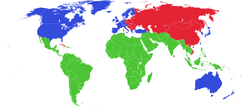
The three worlds as they were separated during the Cold War era, each with its respective allies. In blue, the First World, i.e. the United States and its allies. In red, the Second World, i.e. the Soviet Union and its allies. In green, the Third World, i.e. the non-aligned and neutral countries.
The term "Second World" is a phrase that was used to describe the Communist states within the Soviet Union's sphere of influence. Along with "First World" and "Third World", the term has been used to divide the nations of Earth into three broad categories. The term has largely fallen out of use since the end of the Cold War. The other two 'worlds' are still widely talked about, although "First World" is now deprecated for the more politically correct "developed country" and "Third World" has been replaced with "developing country".
History
The three terms did not arise simultaneously. After World War II, people began to speak of the NATO and Warsaw Pact countries as two major blocs, often using such terms as the "Western bloc" and the "Eastern bloc". The two "worlds" were not numbered. It was eventually pointed out that there were a great many countries that fit into neither category, and in 1952 French demographer Alfred Sauvy coined the term "Third World" to describe these countries; retroactively, the first two groups came to be known as the "First World" and "Second World".
Definition

The three worlds today. The blue countries correspond roughly with the modern First World. The yellow countries correspond roughly with the modern Second World. The red countries correspond roughly with the modern Third World.
The term was used to refer to nations within the Soviet Union's sphere of influence, e.g. the Warsaw Pact countries, as well as farther-flung Soviet Allies such as Cuba and North Vietnam. Besides the Soviet Union proper, most of Eastern Europe was run by satellite governments working closely with Moscow. The term "Second World" may or may not also refer to Communist countries whose leadership were at odds with Moscow after the Sino-Soviet split, such as Albania. After the split with Soviet Union, China considers itself a Third World country. North Korea pursues an isolationist policy that even distances itself from both China and Soviet Union, thus it is also sometimes considered Third World.
There were a number of countries which did not fit comfortably into this neat partitioning of the world, including Switzerland, Sweden, Yugoslavia, and the Republic of Ireland, who all chose to remain neutral. Finland was under the Soviet Union's sphere of influence but was not communist, nor was it a member of the Warsaw Pact. Austria was within the United States' sphere of influence, but in 1955, when it became a fully independent republic, it did so under the condition that it remain neutral. Yugoslavia, a socialist southeast European country, was a founding member of the Non-Aligned Movement. Albania was a communist east European country which withdrew from the Warsaw Pact over ideological differences in 1968 and had stopped supporting the Pact as early as 1962.
Alternatively, First World countries may be defined as having developed market economies, Second World as having developed planned economies, and Third World as having developing economies that may follow either the market or the planned model. The fall of communism and the end of most planned economics has also made this distinction largely moot.
Additionally, the term is often used incorrectly, to describe a moderately developed country. This is most likely based on the misconception that the First World refers to the developed world, the Third World the developing world, and thus the Second World is an intermediate level between the two. To help with this problem, a newer term, Fourth World, was coined to refer to only the most impoverished nations, to distinguish more developed "third world" nations from completely undeveloped "third world" nations.
See also
- First World
- Third World
- Fourth World
- Fifth World
- Sixth World
- Seventh World
- Least Developed Countries (Fourth World)
- Human Development Index
Adapted from the Wikipedia article, "Second World" http://en.wikipedia.org/wiki/Second_World, used under the GNU Free Documentation License.